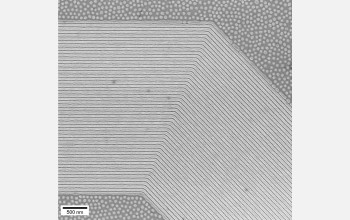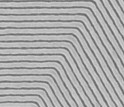News Release 05-092
Self-Assembling Nano-Electronics Turn a Corner

The directed self-assembly process can yield near-perfect nano-arrays.
June 2, 2005
This material is available primarily for archival purposes. Telephone numbers or other contact information may be out of date; please see current contact information at media contacts.
Researchers at the University of Wisconsin-Madison have taken another big step toward complex, nanoscale electronic devices that can be directed to assemble themselves automatically—a development that would allow manufacturers to mass-produce "nanochips" having circuit elements only a few molecules across, roughly 10 times smaller than the features in current-generation chips.
Writing in the June 3 issue of the journal Science, UW chemical engineer Paul Nealey and his colleagues describe how carefully chosen mixtures of polymers can be made to assemble themselves into nanoscale patterns that turn corners and exhibit other complex geometries. Their approach builds upon a similar technique they demonstrated two years ago, using a simpler mix of polymers that could self-assemble only into regular, straight-line patterns of stripes.
The researchers carried out their work at the university's new Nanoscale Science and Engineering Center on Templated Synthesis and Assembly at the Nanoscale, which is funded by the National Science Foundation (NSF).
For more information, see the University of Wisconsin News Release.
-NSF-
-
Directed assembly transforms nanoscale disorder (left) into order (right).
Credit and Larger Version
Media Contacts
James C. Beal, University of Wisconsin-Madison, (608) 263-0611, email: jbeal@engr.wisc.edu
M. Mitchell Waldrop, NSF, (703) 292-7752, email: mwaldrop@nsf.gov
Program Contacts
Thomas P. Rieker, NSF, (703) 292-4914, email: trieker@nsf.gov
Related Websites
UW Center for Nanotechnology: http://www.nanotech.wisc.edu/
UW Nanoscale Science and Engineering Center: http://www.nsec.wisc.edu/
The U.S. National Science Foundation propels the nation forward by advancing fundamental research in all fields of science and engineering. NSF supports research and people by providing facilities, instruments and funding to support their ingenuity and sustain the U.S. as a global leader in research and innovation. With a fiscal year 2023 budget of $9.5 billion, NSF funds reach all 50 states through grants to nearly 2,000 colleges, universities and institutions. Each year, NSF receives more than 40,000 competitive proposals and makes about 11,000 new awards. Those awards include support for cooperative research with industry, Arctic and Antarctic research and operations, and U.S. participation in international scientific efforts.
Connect with us online
NSF website: nsf.gov
NSF News: nsf.gov/news
For News Media: nsf.gov/news/newsroom
Statistics: nsf.gov/statistics/
Awards database: nsf.gov/awardsearch/
Follow us on social
Twitter: twitter.com/NSF
Facebook: facebook.com/US.NSF
Instagram: instagram.com/nsfgov



